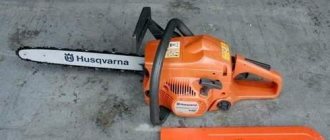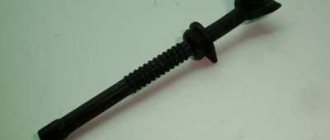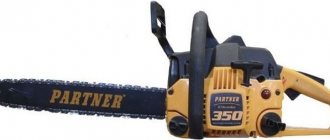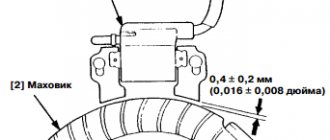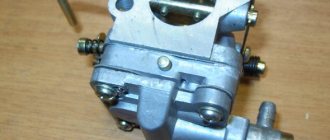Chainsaw chain lubrication system
To supply oil to lubricate the chainsaw chain, the tool uses a special pump, which delivers lubricant to the saw bar in a dosed manner, depending on the number of engine revolutions.
The system uses oil to lubricate the chainsaw chain, which has increased adhesive properties; this is necessary for uniform distribution of oil along the entire perimeter of the bar and retention on it even at high rotation speeds of the chain. Let's take a closer look at the oil supply system implemented in modern chainsaws.
Carburetor adjustment
A separate section covers the carburetor adjustment sequence. Correct tuning of the fuel system contributes to stable traction characteristics and economical fuel consumption.
The work is carried out provided that the air filter is completely cleaned and the power unit is warmed up to operating temperature. By rotating the screws, quantity and quality, the engine is brought to optimal operating mode with good throttle response and stable idle speed.
Additional adjustment may be required when switching to fuel with a different octane number, or when switching the tool to winter or summer operating modes.
Lubrication system design
Depending on the brand of chainsaw, the parts of the lubrication system may vary slightly in design, but their total number and connection diagram remain the same.
The main components of the lubrication system are:
- an oil tank located, as a rule, in the engine crankcase.
- The filter element is installed in the tank.
- The oil line is a small diameter hose made of oil-resistant rubber.
- The heart of the system is the oil pump.
- The worm gear transmits force from the engine to the pump.
- The chainsaw tire can also be considered an element of the lubrication system, since it has special holes for supplying oil. By the way, the chain itself is involved in transporting oil and, accordingly, also has some elements designed specifically to provide lubrication.
Principle of operation
The main unit of the system is the pump. The principle of its operation is as follows. As engine speed increases, a gear mounted on the main shaft drives the pump shaft through a worm gear. In turn, the rotation of the shaft creates a certain pressure in the oil line, which forces the oil to move along it towards the tire.
The end of the oil channel is located at the point of contact of the tire with the tool housing, where there is a longitudinal groove into which, when installing the tire, its oil channel falls.
The groove is necessary to ensure the supply of oil to the bar, regardless of the degree of tension of the chainsaw chain. Simply put, no matter what position the tire is in at the time of operation, oil will get onto it through the groove.
Next, the lubrication process includes a chain, on the links of which, depending on the chain model, there is either a groove or a hole through which the oil is dispersed throughout the tire. As engine speed increases, the oil flow rate also increases.
Some models of chainsaws are equipped with pumps that additionally have capacity adjustment, and if necessary, the amount of oil supplied by the lubrication system can be increased or decreased.
This function is quite convenient, because it allows you to save money and not waste extra oil.
Separately about the breakdown of the most common model
Let's look at the obstacles of the Stihl 180 in more detail:
- Clogged carburetor or fuel filter. These are the most common difficulties that are not at all difficult to eliminate after cleaning. From time to time the filter has to be changed;
- Changing the candle;
- From time to time the cylinder or seals need to be replaced.
The Stihl saw is quite strong and durable, so you can often fix a breakage yourself. Almost the same applies to the Partner, Ural, Makita and Husqvarna
When we detect a malfunction in our own chainsaw, we look for the cause from a small point of view, regularly checking and eliminating problems. Such problems can be easily removed without the help of others. But if the breakdown is severe, and you do not have enough experience, then this should be done by a specialist.
Problems in the fuel system
If upon inspection it is discovered that there is a spark, but the spark plug is dry, this means difficulties in the fuel system. Checking it should start with the fuel filter
Next, you need to examine the fuel hose and its attachment to the carburetor, pay attention to fuel leaks from the carburetor and the presence of gasoline in the air filter housing. It is advisable to begin removing the carburetor only if a visual inspection does not allow you to find the cause of the breakdown.
A corresponding sign of a problem in the fuel system is an excess amount of fuel in the engine cylinder. Typically, signs of this are an extremely wet spark plug and the presence of a spark at the spark plug contacts. In this situation, you need to turn the chainsaw over so that the spark plug hole is oriented downward. If, with all this, gasoline flows from the cylinder, then the reason that the chainsaw does not start is that fuel has overflowed into the engine.
“Fills” with fuel, from time to time due to incorrect carburetor adjustment or malfunction.
You can familiarize yourself with the process of adjusting the carburetor using the example of the Champion 254 saw, by looking at the annotation.
Reduced compression
One of the frequent cases of difficulty starting a chainsaw is wear of the CPG (cylinder-piston group).
As is clear, for a chainsaw to start normally, there must be compression in its engine. It is needed for normal compression of the fuel mixture in the engine cylinder, and it also affects the operation of the fuel pump.
During the use of the tool, the compression indicator value drops, and the chainsaw
starts having trouble starting.
The prerequisites for the absence of compression, or its decrease, may be natural, because The engine wears out during operation. Problems can also be caused by a severe breakdown, for example, a scuffed CPG, or a broken piston ring.
A sign of low compression is weak starter resistance when starting. With reduced compression, a decrease in the power of the chainsaw is observed, which negatively affects its performance. The problem is eliminated by replacing the piston rings, or even the CPG.
Lubrication system malfunctions and how to fix them
The main malfunctions of the oil supply system on a chainsaw can be divided into two main types: these are general malfunctions inherent in all chainsaws and individual ones, which may vary depending on the type of pump and worm gear installed on a particular model. Let's begin to understand the faults in order.
Operating a chainsaw without lubricating the chainsaw chain is prohibited. This has a detrimental effect on the bar, drive sprocket and chain, and can result in significant repair costs.
Signs of a malfunction of the lubrication system, checking its performance
- The chainsaw chain is dry and has a pale tint without shine.
- The chain stretches relatively quickly.
- The tire is very hot and may even partially melt the paint.
- The oil from the tank is practically not reduced.
- Reduced cutting efficiency on a sharp chain
All these signs indicate that the lubrication process is not proceeding properly. In order to check the oil supply to the lubrication system, you need to remove the side tire of the chainsaw and start it. Next, you need to slightly increase the speed while observing the end of the oil line. If oil comes in, most likely the amount is not enough for normal lubrication and you need to clean or replace the filter and, if possible, adjust the flow. If it does not, the problem is more serious and requires further diagnosis.
There is a way to check the oil supply without removing the tires. To do this, you need to point the end of the bar towards, for example, a freshly cut piece of wood from the side of the cut and increase the speed as much as possible, while trying to keep the end of the bar at a distance of no more than 10 cm from the block. If oil spots begin to appear on its surface, it means the oil is being supplied.
Troubleshooting
Once it has been determined that oil is not being supplied, further diagnosis is only possible if the oil system is completely removed. Of course, in some situations replacing the filter helps, but this is very rare.
Access to the oil pump of some models of saws is possible only after complete disassembly; therefore, without having the skills to repair gas-powered tools, it is better to entrust repairs to professionals.
Most common faults
- Broken oil hose. It can sometimes be detected by visual inspection. The problem is solved by replacing the faulty part.
- There is no thread on the oil pump shaft; replacing it will help.
- A defective thread on the pump drive gear can be similarly solved by installing a new part.
- Lack of main shaft corkscrew (relevant for some instrument models, for example, Homelite). You can fix it by installing a nail of a suitable diameter instead of the original corkscrew, cutting it to the required length.
- Blockage in the line. Can be removed by blowing with compressed air or mechanically, using a wire of a suitable diameter.
- Filter element clogged.
- The Stihl MS 180 tool, whose pump is not dismountable, often gets clogged. You can try to wash it in clean gasoline, if that doesn’t help, replace it.
- In Chinese chainsaws (Gypsy), it very often cuts off the grooves on the main gear, through which the force from the sprocket is transmitted to it.
Individual malfunction of the Stihl MS 180 lubrication system
Due to the fact that the Stihl MS 180 is one of the most common models of chainsaws, I would like to dwell in more detail on one fault inherent only to it and describe a method for eliminating it without replacing parts.
Quite often, on the Shtil MS 180 chainsaw, depressurization of the oil line is observed in the place where the oil line coming from the tank is installed in the saw body. The malfunction can be determined by the characteristic lubricant leaks on the bottom of the tool.
To eliminate the problem, you need to remove the chainsaw handle, remove the hose from the mounting hole, clean and degrease. After all these manipulations, apply sealant to the hose seat and install it into the chainsaw body.
You can learn more about troubleshooting and complete diagnostics of the lubrication system of the Stihl chainsaw by watching a video that shows the step-by-step process of disassembling and repairing the lubrication system.
Replacing the oil pump using the example of a Chinese saw Partner
The oil pump is a fairly reliable element of the chainsaw. However, during operation, malfunctions may occur, the elimination of which requires its replacement. For example, to dismantle the oil pump on a “Partner” chainsaw, you must perform the following steps:
- Unscrew the bolts securing the crankcase cover;
- Remove the cover;
- Move the saw chain to the side and remove the bar;
- Remove the saw chain;
- Remove the air filter housing and the filter itself;
- Remove the spark plug;
- Unscrew the starter cover and remove it. This is necessary so that during the process of cranking the engine crankshaft, the ratchet teeth do not deform and the starter does not break;
- While turning the flywheel, set the piston at top dead center (directly below the spark plug hole) and insert a pre-prepared fabric harness into it. This will help fix the piston in one position and protect the walls of the combustion chamber from mechanical damage;
- Using a puller, unscrew the clutch retaining clip. Unscrewing must be done clockwise. To do this, some models have a stamping with an index arrow and the inscription “Off”;
- Remove the friction element, drum and clutch bearing;
- Remove any remaining dirt formed during work;
- Using a screwdriver, move the cover lock to the side and remove it;
- Unscrew the screws securing the pump;
- Carefully, using a screwdriver, pry the pump housing up and lift it to the side and remove it from the mounting socket. After this, it is necessary to turn off the supply and suction lines.
Installation of a new pump is carried out in the reverse order.
We also recommend watching the video instructions, the author of which explains in detail and shows how to replace the oil pump on a Partner chainsaw.
Husqvarna Chainsaw Chain Lubrication System
Operation the Husqvarna 137 chainsaw
I bought a Husqvarna 137 chainsaw. During operation, a question arose. Should chain oil and gasoline run out immediately? I ran out of oil quickly. I think this is incorrect. Could there be something wrong with the saw?
In the saw, oil should be used for two purposes. mix with gasoline (if this is provided for by the design) and lubricate the chain. Main expense. chain lubrication. Because if you cut intensively. then it will end faster. And if you don’t cut anything, but just gas it. then the gasoline will quickly run out. Do not leave the chainsaw idling, as when the engine is running, the oil supply automatically turns on to lubricate the bar and chain. You can use a special screw to regulate the oil supply to the tire. If the oil is thin, it may run out faster than gasoline.
I'm confused by the presence of a metallic sound in the Husqvarna 137 chainsaw, like a bearing or something else in the clutch area here and there, is this normal or does something need to be lubricated and tightened?
This is the clutch cup ringing while it is new and completely unsullied on the inside. Over time, a certain amount of adhering dust will appear there and the hum will end.
I saw that the tire had become an arc. I can't understand why this happened. I did not apply lateral forces. If you place the tire on a flat surface, then the middle is 2-3 mm away from the axle. I straightened it out in a vice slowly, it became even. I haven't tried sawing yet. Could this happen due to tire overheating? And it also began (when warmed up) to stall from time to time when pressing the gas.
The worst thing is if the hot chain is pulled tight, but is not immediately loosened after work. So the tire bent like an onion. The best case is if it was immediately deformed, but was only seen now. In the first case, serious engine repair cannot be avoided. deformation of the crankshaft toe, damaged bearings and their beds.
I bought a Husqvarna 137 saw, problems immediately appeared with the carburetor, tell me what can be done, are there any adjustments? Unstable at idle
and when you press the gas approximately halfway through, it seems to choke, and later it seems to be normal, but only at full speed.
I bought a fake, what next?
What to do if you were in a hurry and already bought a Chinese chainsaw called “Husqvarna” 5200? The main thing is not to get upset and prepare for the fact that you will have to do all the repair and adjustment work yourself. Most likely, you will not find the operating instructions included with the saw, so to properly start the tool, refer to the video instructions:
READ Adjusting the Carburetor of the Vityaz Chainsaw
As for repairs and adjustments of the carburetor, lubrication, etc., the design of the internal combustion engine and other systems is identical for all chainsaws, with the exception of some nuances, so you can be guided by similar devices. The characteristics are also not fully presented; the Chinese manufacturer indicated only the most basic ones:
| Model | Husqvarna 5200 |
| Cylinder volume | 25 cm3 |
| Number of revolutions at idle | 3 thousand rpm. |
| Tire length | 40 cm. |
| Fuel tank capacity | 550 ml. |
| Chain lubrication tank volume | 260 ml. |
| Ready to use weight | 5.3 kg. |
As a consolation, we can say that this tool also works; with proper maintenance, the chainsaw can work for quite a long time before the first repair. Spare parts are inexpensive - this is also a big plus.
Run-in
The running-in procedure for moving components lasts about 10 hours. The chainsaw is not loaded during this period; the power during operation should not exceed 50% of the rated power of the power plant.
Safety requirements
- Fill the saw with fresh mixture.
- Start the chainsaw at a distance of at least 3 m from the refueling point.
- Do not smoke while operating or servicing the tool.
- Use personal protective equipment.
- To avoid kickback, do not cut with the end of the bar, only cut with the entire blade. lowering the chainsaw from top to bottom.
- When working, hold the chainsaw with both hands.
Adjusting the carburetor on a chainsaw (video review)
Oil does not flow to the chainsaw chain: causes and solutions
When the saw chain of a chainsaw moves in the groove of the bar due to friction, a large amount of heat is released. If oil does not flow to the chainsaw chain, it is necessary to stop work and take all measures to eliminate the malfunction of the lubrication system. The combination of heavy loads and overheating of the headset is accompanied by its accelerated wear and early failure.
- Without exception, all chainsaws and their electric analogues are equipped with systems of the same operating principle, through which the lubrication of the bar, saw chain and its drive parts is carried out.
- The standard composition of this device includes a reservoir from which chain oil is supplied to the inlet of a pump with a fixed or adjustable capacity.
- Next, the working fluid in a dosed amount enters the groove of the bar, in which it is evenly distributed by the shanks of the saw chain over the entire headset and the working surface of the drive sprocket crown.
Performance tires with a length of 400 mm or more are equipped with a driven sprocket. Periodic lubrication of the bearing is carried out individually, after 6-8 hours of operation.
Break-in rules
Running in a chainsaw is not carried out for a long time at XX. Therefore, after starting the engine, you need to idle for about 5 minutes, then start sawing trees with a diameter of less than 10 cm at medium speed.
The technological process is carried out according to a repeating pattern:
- 1.5 minutes with a minimum load;
- 20 seconds on XX without it.
After operating for the first 25 hours, the unit can reach full power; all rubbing parts are worn in.
During this period, be sure to adhere to the following advice:
- do not overheat the power plant;
- do not work for a long time at XX;
- do not load too much;
- curb long-term clutch slippage.
READ Which Oil Is Suitable For Electric Saws
After final running-in, the following work is carried out:
- inspection of the crank mechanism;
- cleaning carbon deposits on all parts;
- checking fasteners;
- assembly;
- preparation of flammable consistency;
- adjusting the carburetor to the highest power under load.
The saw chain also needs running-in. Attention is paid to its lubrication and tension. The part is tensioned so that it can be rotated freely by hand. Lubrication is done by immersion in oil. Then the chain is run at XX for 3-5 minutes. The engine is stopped, the chain cools down and only later is the tension checked.
Gap between ignition coil and flywheel
An incorrectly set gap between the flywheel and the ignition coil contacts affects the quality of spark formation, which in turn is responsible for the normal starting and smooth operation of the engine.
Signs of a malfunctioning lubrication system
The correct choice of consumable lubricant and flawless operation of the system contribute to complete lubrication, effective cooling of sawing equipment and the complete exhaustion of its service life.
There are several external signs that the chain on a chainsaw is not lubricated. First of all, this:
- constant oil level in the tank;
- increased load on the engine;
- accelerated wear of the cutting edges of saw links;
- characteristic smell of overheated wood.
In the simplest version, the cause of oil starvation may be clogging of the oil channels with sawdust. This drawback is typical for budget headsets that do not have convenient access to problem areas.
Technical characteristics of garden tools
The use of high-quality working mechanisms in the production of the Husqvarna 450E model allowed the manufacturer to increase its factory parameters. These include:
- petrol engine power – 3.26 liters. With.;
- recommended bar length/chain pitch – 33 cm/0.325″;
- sound pressure during operation – 104 dB;
- vibration to the front/rear handle – 2.30/2.70 m/s 2 ;
- weight with installed saw set – 5.4 kg.
Despite the relatively high rated power for a semi-professional chain tool, the model stands out for its reduced fuel consumption. When operating the saw under maximum engine load, this parameter is 0.5 l/hour of operation.
As previously noted, the proportions of oil and gasoline for a chainsaw can differ significantly, largely depending on the features of the design itself. VladlenPopolitov Khimki May 25, 200412 59 21 Any automotive mineral oil is better than waste oil, and waste oil is better than sawing without oil at all.
| Chainsaw Stihl 180 Run-in According to the manual of the German Stihl saw, to refuel it you need to use only gasoline of a grade not lower than AI-92, as well as branded oil for Stihl 2-stroke engines. The collection of standards for the consumption of fuels and lubricants for mechanized work performed in forestry includes individual consumption standards for fuel and lubricants for the main types of work: silvicultural work in nurseries, uprooting stumps in clearings with tractor units, continuous tillage for forest crops, nurseries and agricultural crops, sowing and planting forests, agrotechnical and silvicultural care; forest protection work: spraying, pollination and aerosol treatment of forest crops; forestry work, thinning in young forests, during thinning, through-cutting and sanitary felling, wood skidding; irrigation and forest drainage work, road construction, work on preparing routes for a forest drainage network, work on installing a forest drainage network on a prepared route; fire prevention measures; transport work. |
| Fuel Consumption Stihl Ms Chainsaw • Due to constant vibration, the factory settings of the carburetor are violated, which leads to an arbitrary cessation of fuel supply and shutdown of the Stihl chainsaw motor. If the tool is used frequently, one of its fuel pipes may be torn, which will lead to fuel spilling onto the spark plug and other parts of the saw. |
- Turn on the ignition (how to set the ignition on a Shtil 180 chainsaw is indicated in the device passport).
- Set the control lever to its lowest point (this will allow the carburetor choke to cut off air from the filter and keep the throttle fully open, allowing the fuel mixture to richen).
- Pull the starter handle, this must be done several times before the first flash passes. This will signal that the mixture has entered directly into the cylinder, and your unit is ready to start.
- Now you can move the lever up one section, while the throttle valve will remain in the same position and the air valve will open.
- All you have to do is pull the starter. At the same time, the Stihl MS 180 chainsaw will operate at higher speeds.
Reasons for decreased system performance and efficiency
The required amount of oil is not supplied to the chainsaw chain for several reasons. The most common failures include:
- clogging of the filter located in the oil tank;
- mechanical failure of one of the pump worm drive elements;
- In winter, the performance of the blower is reduced due to filling the system with too thick oil.
In the latter case, the drive and all pump parts operate under increased loads, causing serious mechanical damage.
STIHL MS 180 carburetor repair
Repairing a STIHL MS 180 carburetor is a very difficult process. Note that during repairs there is practically no risk of sudden changes in the cylinder-piston group.
If the chainsaw does not start, then follow these steps:
1) open and close the gas tank cap;
2) it is advisable to remove the candle and then dry it;
3) ventilate the combustion chamber.
If after this there are no positive results, then it is better to check the condition of the air filter, the gasoline supply process and the functioning of the spark plug.
This problem is associated with a valve (slepun), which becomes clogged, and as a result a vacuum is formed. Everything about repairing a chainsaw with your own hands. My chainsaw is leaking oil for no reason. To eliminate this inconvenience, you need to clean the valve (slepun) with a needle.
Systematically check the filter; if the muffler is clogged, the device will not be able to deliver the power that is put into it.
If the chainsaw was purchased with a warranty (as a rule, there is no other option), immediately take it to the service center.
Thus, the STIHL MS 180 chainsaw is very easy to use, has good ergonomics and a number of significant advantages.
Home page » How to Fix Oil Leaks in a Chainsaw
Feature of independent troubleshooting
A complete independent repair of chainsaw chain lubrication, all things being equal, requires knowledge of the interaction of all elements of the system, the availability of tools and plumbing skills.
Restoring the operating parameters of many chainsaws involves partial or complete dismantling of the component equipment. To perform complex repair work, it is better to use the capabilities and technical potential of service workshops.
Parts with broken threads and damaged spline joints, as well as non-separable structures that come with the lubrication system of popular Shtil 180 chainsaws and other similar models must be replaced.
If, when the tank is filled, oil does not flow into the headset structure, the reason should be sought in the pump itself. Dismantling and disassembling the mechanism will help identify faulty parts and eliminate the problem by replacing them.
on this topic
Share articles on social networks and comment. And I say goodbye to you, good luck and see you again!
Carburetor adjustment
Incorrect carburetor adjustment will cause the chainsaw
will not develop full power. It will be difficult to start, or not start at all. Carburetor settings directly affect the quality of the air-fuel mixture, which is necessary for normal starting and future operation of the engine.
If the carburetor is incorrectly adjusted, the mixture of fuel with air will contain more or less gasoline than required, and the mixture will not ignite even with normal sparking.
Excess gasoline in consistency is usually called overflow. A corresponding sign of overflow is a wet spark plug, after several unsuccessful attempts to start the chainsaw.
Checking the system for oil output and performance
A dirty oil filter results in a significant reduction in pump performance. It is easy to check this parameter. To do this, you need to hold the headset of the saw running at working speed over a clean sheet of paper.
Based on the density and size of the oil strip, you can confidently judge the condition of the system and the complexity of the upcoming repair.
To the question why the repaired lubrication system works, but the chain does not receive oil in the required quantity, there is no definite answer. The reason for the failure may be errors made during assembly, failure of standard adjustments, or a discrepancy between the density and viscosity of the selected composition and the declared characteristics.
Oil starvation of the headset is possible when installing a longer productive bar on a household saw with a non-regulated pump, which is included with professional-class chainsaw equipment.

